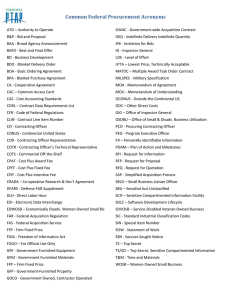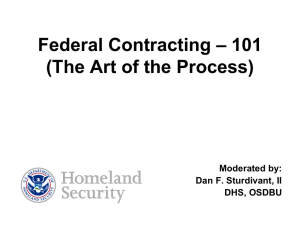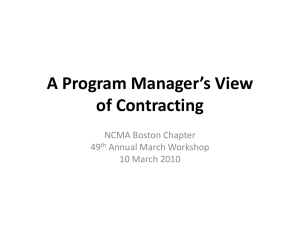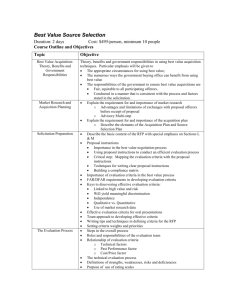U.S. Small Business Administration
advertisement
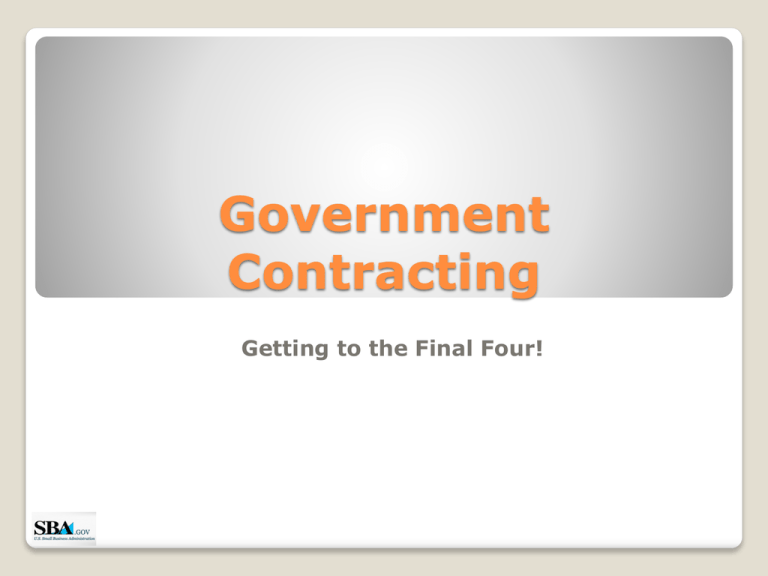
Government Contracting Getting to the Final Four! Practice And Study of the Game Facts about Federal Contracting The federal government is one of the largest single sources of US contracting opportunities for small businesses Contracts exist for every item imaginable, from paper clips to armored tanks The world’s largest buyer of goods and services is the Federal Government, with purchases totaling more than $500 billion per year. Federal agencies are required to establish contracting goals, with at least 23 percent of all government buying targeted to small firms. Monitored by SBA through a network of PCRs Prime Contracting Goals 23% of all prime contracts is to be set aside for small businesses ◦ 5% of all prime and subcontracts is to be set aside for small disadvantaged businesses ◦ 5% of all prime and subcontracts is to be set aside for woman-owned businesses ◦ 3% of all prime contracts is to be set aside for HUBZone small businesses ◦ 3% of all prime and subcontracts is to be set aside for to Service Disabled Veteran-Owned Small businesses Contracting Officers Receive requirement and review for ‘procurability,’ approvals, and appropriate funding. Do market research to determine available vendor sources. Based on market research, decide an acquisition strategy that conforms with Federal Laws and Regulations, specifically implement socio-economic programs, as required. Build a solicitation that conforms to the acquisition strategy. Solicit quotes/bids/proposal(s) from eligible vendors. Evaluate/negotiate with vendors, resulting in selecting successful offeror/bidder. Award and administer and, eventually, closeout the contract. Maintain a close working relationships with their local SBA district offices PCRs Procurement Center Representatives SBA Procurement Center Representatives (PCRs) are generally located at Federal agencies and buying activities which have major contracting programs. PCRs are responsible for reviewing all acquisitions not set-aside for small businesses to determine whether a set-aside is appropriate and to identify alternative strategies to maximize the participation of small businesses in the procurement. (2) As early in the acquisition planning process as practicable, but no later than 30 days before the issuance of a solicitation, or prior to placing an order without a solicitation, the procuring activity must coordinate with the procuring activity's Small Business Specialist (SBS) when the acquisition strategy contemplates an acquisition meeting the dollar amounts in paragraph (b)(2)(i) of this section, unless the contract or order is entirely reserved or set-aside for small business concerns as authorized under the Small Business Act. CMRs Commercial Marketing Representative Commercial Market Representatives (CMRs) are SBA's subcontracting specialists. CMRs are responsible for: Facilitating the matching of large prime contractors with small business concerns; Counseling large prime contractors on their responsibilities to maximize subcontracting opportunities for small business concerns; Instructing large prime contractors on identifying small business concerns by means of the SAM, SUB-Net, Business Matchmaking events, and other resources and tools; Counseling small business concerns on how to market themselves to large prime contractors; Maintaining a portfolio of large prime contractors and conducting Subcontracting Orientation and Assistance Reviews (SOARs). SOARs are conducted for the purpose of assisting prime contractors in understanding and complying with their small business subcontracting responsibilities, including developing subcontracting goals that reflect maximum practicable opportunity for small business; maintaining acceptable books and records; and periodically submitting reports to the Federal government; and Conducting periodic reviews, including compliance reviews in accordance with paragraph (f) of this section. Small Business Specialist As early in the acquisition planning process as practicable, but no later than 30 days before the issuance of a solicitation, or prior to placing an order without a solicitation, the procuring activity must coordinate with the procuring activity's Small Business Specialist (SBS) when the acquisition strategy contemplates an acquisition meeting the dollar amounts in paragraph (b)(2)(i) of this section, unless the contract or order is entirely reserved or set-aside for small business concerns as authorized under the Small Business Act. Offices of Small and Disadvantaged Business Utilization (OSDBU) The goal of the OSBDU offices is to advocate for and manage the small business utilization programs for their organization. The Director of the OSDBU - primary advocate responsible for promoting the maximum practicable use of small business within the Federal Acquisition process. The OSDBU is tasked with ensuring that each Federal agency and their large prime vendors comply with federal laws, regulations, and policies to include small business concerns as sources for goods and services as prime contractors and subcontractors. Federal OSDBU Offices/Small Business Specialists: http://www.osdbu.gov/offices.html SBA - Resource Partners PTACs- provide assistance to business firms in marketing products and services to the Federal, state and local governments available at no or nominal cost www.dla.mil/db/procurem.htm Small Business Development Centers – provide one on one management assistance to SB; Women Business Centers: http://www.sba.gov/aboutsba/sbaprograms/onlin ewbc/index.html SCORE - Get free & Confidential small business mentoring and advice (online and in-person mentoring) from Successful Business Advisors www.score.org Federal Contracting Procedures In order to win federal contracts, you will want/need to become familiar with federal regulations Federal Acquisition Regulations (FAR) www.acquisition.gov/far Subpart 8.4 – Federal Supply Schedules Part 12 – Commercial Items Part 13 – Simplified Acquisitions Part 14 – Sealed Bidding Part 15 – Contracting by Negotiation Part 19 – Small Business Programs Defense Federal Acquisition Regulation Supplement (DFARS) www.acq.osd.mil/dpap/ GSA’s Regulations: https://www.acquisition.gov/gsam/gsam.html Training available through SBA 7(j) training and @ SBA.gov Competition Competitive Analysis Market Research Federal Agency Procurement Forecasts: http://acquisition.gov/comp/procurement_forecasts/index.htm l Federal Business Opportunities (FedBizOpps) (FBO) is the exclusive official source to identify federal contracts over $25,000 www.fedbizopps.gov or www.fbo.gov Federal Procurement Data System – Next Generation www.FPDS.gov Increased use of Sources Sought Notices in the FBO – Become familiar with and Respond to these notices. Pay attention to what specifically the agency is asking for in the notice. Large contract awards and special notices (e.g., procurement conferences) are also publicized in the FBO. FPDS - ezSearch Returns Search on NAICS or DUNS numbers and returned numerous results. Drill into the results to obtain more information. 14 Analyzing your Sweet Spot 17 Game Time Compliance and Content Keep it Moving and Improving! Attend procurement conferences and business expos Become a member in key associations Attend Business Matchmaking events Conduct routine SWOT analysis Add details to DSBS your Dynamic Small Business Search profile (e.g., GSA schedule number, commercial customers, federal customers, special capabilities). Attend training (e.g., Contracts administration, Project management, 7(j)) The Acquisition Lifecycle Leads Q0 Q1 Q2 Q0 Identification Q1 Qualification Q2 In Process Review / Develop. T3 Finalize Capture Plan T3 B4 B4 Proposal Development S Submitted Proposal (Post-Marketing Activity) S 20 Compliance: The Key to It All Three Rules for a solicitation Read it…Read it…Read it!!! Compliance to Proposal Instructions: Section C, L, and M specifically Sound Management Plan inclusive of your management structure and governance Balance between their requirements and your win strategies Focus on Your Discriminators, and Ghost if necessary Low Risk, Efficient Solutions Win - The government is not signing up for your problems. On-Time delivery Uniform Contract Format Part I--The Schedule A Solicitation/contract form B Supplies or services and prices/costs C Description/specifications/work statement D Packaging and marking E Inspection and acceptance F Deliveries or performance G Contract administration data H Special contract requirements 22 Uniform Contract Format (cont.) Part II--Contract Clauses I Contract clauses Part III--List of Documents, Exhibits, and Other Attachments J List of attachments Part IV--Representations and Instructions K Representations, certifications, and other statements of offerors L Instructions to offerors M Evaluation factors for award 23 Past Performance A New Dynamic Is in Play Questionnaires Drive a Need for Client Relationship Management Recent, Relevant and Tailored Approach Ensure Evaluation Criteria are met Review Section L (instructions) & Section M Work completed in the last three years Similar in scope, complexity and size When asked to address problems, show how company worked with the client to turn things around and deliver a successful project 24 Key Resources / Responsibilities Business Developer ◦ Corporate or Division resource responsible for targeting, identifying and pursuing new business opportunities. Capture Manager (CM) ◦ From Corporate or Division; responsible for developing and implementing a winning strategy; Serves as the main focal point for the opportunity once a bid decision is rendered. Proposal Manager or Proposal Coordinator (PM) ◦ Assists the CM with coordinating, managing, editing, and formatting the proposal. Solution Architects and Subject Matter Experts (SME) ◦ Technical expert from the Division or a team used to write specific portions of a proposal who may be member. 25 Proposal Review Process Pink Team Develop Draft Red Team Update Proposal Gold Team Finalize Proposal In-process Review(s) White Glove Submit to Client 26 Winning Source Selection – How It Works Source Selection The objective of source selection is to select the proposal that represents the best value. Ensure consistency among the solicitation requirements, notices to offerors, proposal preparation instructions, evaluation factors and subfactors, solicitation provisions or contract clauses, and data requirements; Ensure that proposals are evaluated based solely on the factors and subfactors contained in the solicitation. Competitive Range Agencies shall evaluate all proposals in accordance with 15.305(a), and, if discussions are to be conducted, establish the competitive range. Based on the ratings of each proposal against all evaluation criteria, the contracting officer shall establish a competitive range comprised of all of the most highly rated proposals, unless the range is further reduced for purposes of efficiency. Provided the solicitation notifies offerors that the competitive range can be limited for purposes of efficiency (see 52.215-1(f)(4)), the contracting officer may limit the number of proposals in the competitive range to the greatest number that will permit an efficient competition among the most highly rated proposals (10 U.S.C. 2305(b)(4) and 41 U.S.C. 253b(d)). ( 15.307 Proposal revisions If an offeror’s proposal is eliminated or otherwise removed from the competitive range, no further revisions to that offeror’s proposal shall be accepted or considered. The contracting officer may request or allow proposal revisions to clarify and document understandings reached during negotiations. At the conclusion of discussions, each offeror still in the competitive range shall be given an opportunity to submit a final proposal revision. The contracting officer is required to establish a common cut-off date only for receipt of final proposal revisions. Requests for final proposal revisions shall advise offerors that the final proposal revisions shall be in writing and that the Government intends to make award without obtaining further revisions. Source Selection Decision Based on a comparative assessment of proposals against all source selection criteria in the solicitation. The source selection decision shall represent the SSA’s independent judgment. The source selection decision shall be documented, and the documentation shall include the rationale for any business judgments and tradeoffs made or relied on by the SSA, including benefits associated with additional costs. Although the rationale for the selection decision must be documented, that documentation need not quantify the tradeoffs that led to the decision Conclusion Know The Rules Select Wisely Do Your Homework Compliance Is Everything Source Selection FAR 15.300-308 Compliance 32 Questions and Answers 33


